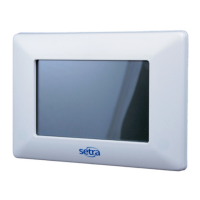11
© Setra Systems, Inc. All Rights Reserved. The Setra Systems name and logo are registered trademarks of Setra Systems, Inc.
Network-only Mapping BACnet Objects
FLEX is able to take any sensor input as a network variable
by binding BACnet objects from third-party BAS controllers
(or any BACnet source). This network access to sensors
can be used in addition to, or in lieu of hard-wiring sensors
to the FLEX unit. For example, a pressure sensor wired to a
third-party controller may map the pressure output signal
to a BACnet object in that controller. This BACnet object
maythenbemappedtoFLEXviacongurationsettings.
In a similar manner, variables from temperature, relative
humidity, air changes per hour, and other variables can be
mapped to FLEX for display and alarming on the home
screen. The end-user can choose up to six networked
sensors to show on the display.
Plumbing
For either on-board or external sensors, typically a
Pressure Pickup Port is installed in the primary monitored
room and another one is installed in the reference area
(typically a hallway). 0.25” nylon tubing is typically used to
bring the pressure signal from this point of measurement
tothepressurettingsonthebackofthepressuresensor.
A single reference area may be used to serve several
rooms, as long as the reference area is in the intended
adjacent space for the differential pressure reading. In
this manner, tubing from a single Pressure Pickup Port
can have several “T” junctions for additional tubing runs
to the LOW side of each sensor (one, two, or three sensors
supported by FLEX).
Installing a single gang electrical box anywhere inside
the room, typically high on the wall or flush-mounted to
the ceiling is appropriate. This will be used for the room
pressure signal (room pressure port is labeled HIGH and
reference port is labeled LOW). Run 0.25” tubing from this
electrical box to the on-board or external sensor used with
FLEX.
Attachpressuretubingasfollowsfornalconnections:
• Install the supplied silicone tube (with integrated external
spring) and attached barbed tube adapter onto the end
ofthe0.25”eldtubing.
• For the ROOM side, push the open end of the soft silicone
tubing onto the on-board or external sensor HIGH port.
• For the REFERENCE side, push the open end of the soft
silicone tubing onto the on-board or external sensor
LOW port.
Location of Pressure Pickup Ports
Caution should be taken to locate Pressure Pickup Ports
at least six (6) feet from air turbulence that may originate
from air supply diffusers, slot diffusers, mobile equipment
cooling fans, or other devices that may exhaust air in the
direction of the ports. Air velocity blowing directly on these
ports can cause inaccurate pressure measurement.
Surface Mounting on Wall
For installations where inserting the unit into the wall is
not possible, mount the optional adapter box to allow
installation of the Setra FLEX unit (Setra P/N 229973 for
FLEX units without on-board pressure sensor. Setra P/N
229971 for FLEX units with on-board pressure sensor).
• Align the adapter box appropriately, mark and drill four
holes for plastic sheet rock anchors using a 3/16"
diameter drill bit.
• Gently tap the sheet rock anchors into place
• Align adapter box to sheet rock anchors and fasten
adapter box to wall using four screws (provide in the
optional adapter box kit).
• Mount the Setra FLEX unit onto the adapter box
Rough-in Installation

